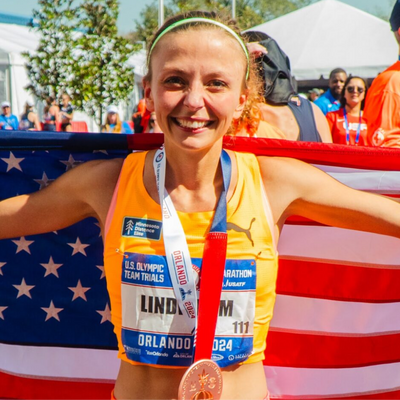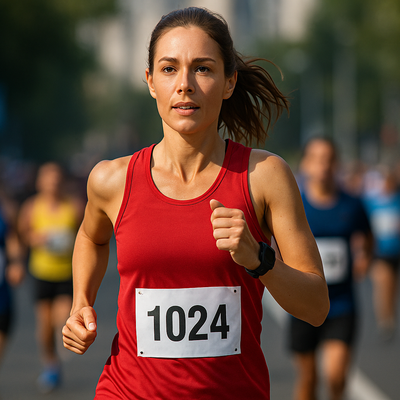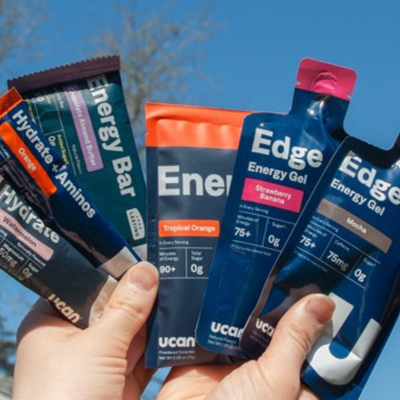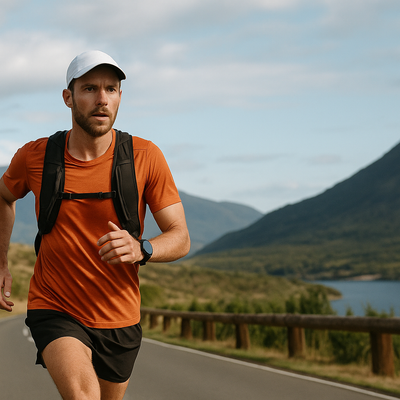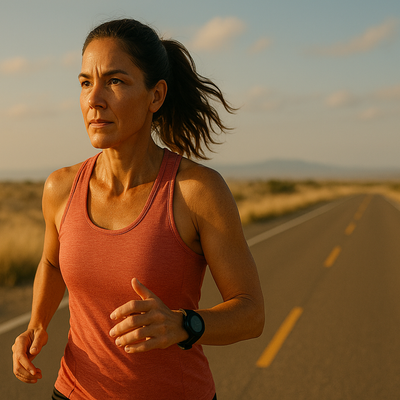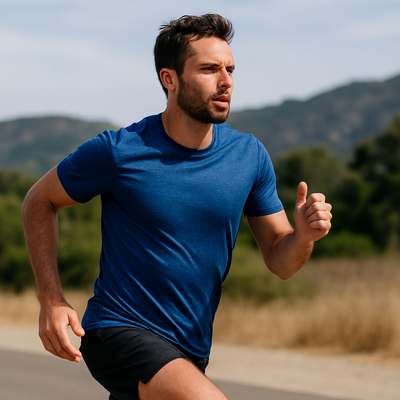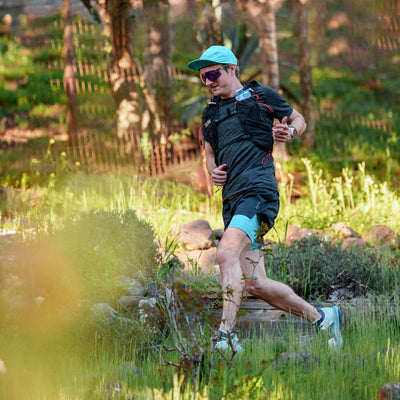Join legendary cycling coach Hunter Allen for an exclusive webinar on fueling with continuous glucose monitors (CGMs).
As co-founder of TrainingPeaks and co-author of Training and Racing with a Power Meter, Hunter has redefined how athletes train with data. Now, with insights from his new book Training and Competing with a Continuous Glucose Monitor, we discuss CGM and UCAN can transform your fueling for stable energy and peak performance.
This transcript has been edited slightly for clarity.
Moderator (Varun Sriram): Welcome, everybody, to Fuel Smarter, Train Stronger with UCAN and Hunter Allen. Today we’re going to have a great discussion around continuous glucose monitoring and how it can positively impact both health and performance—whether you’re a cyclist, an endurance athlete, or just someone who’s active.
Hunter brings a wealth of knowledge from the cycling and endurance world. He’s a legendary cycling coach, co-founder of TrainingPeaks, co-author of Training and Racing with a Power Meter—one of the foundational training books in cycling—and, most recently, author of Training and Competing with a Continuous Glucose Monitor.
Hunter, welcome, and thank you for lending your expertise to today’s discussion.
Hunter Allen: Thanks, Varun. This is super fun—I’m really glad to be here. It’s been an amazing journey being part of UCAN, and also just continuing my own path as a cycling coach and learner. I’m happy to share my knowledge with as many people as possible.
Varun: Wonderful. Let’s start with your background before we dive into glucose monitoring: what it is, why it matters, and how athletes can apply it to their own training. We’ll give everyone some context and also leave them with practical tips they can take away.
So Hunter, you became really well known through TrainingPeaks and your book Training and Racing with a Power Meter. But take us back to the early days—how did you get started in the sport, and what keeps you passionate about doing what you do today?
Hunter: It’s been a really fun journey. Hard to believe, but it’s been 25–26 years since we first started using power meters in cycling. Back then, I had an athlete come to me and say, “Hey, I’ve got this power meter. I don’t really know what it does—would you coach me with it?”
I didn’t have one when I was racing professionally in the ’90s, so I said, “I don’t know either, but let’s try.” He started sending me spreadsheets with numbers like 300 watts, 200 watts—and honestly, I didn’t know what they meant. So I bought a power meter myself, went out training, and started to figure it out.
That athlete, Kevin Williams, happened to be a computer programmer. Together, we built some software to analyze the data—originally called CyclingPeaks, which eventually became TrainingPeaks. At first, we thought maybe we’d sell 100 copies, but it really took off. TrainingPeaks has since become an incredible company. I haven’t been involved for about 10 years now, but it was my baby for a long time, and I still use it every day with my athletes.
Along the way, Dr. Andy Coggan and I wrote Training and Racing with a Power Meter, published in 2006. Honestly, we didn’t set out to revolutionize cycling—we just got tired of answering the same email questions over and over! So we wrote the book, and it’s been amazing to see the impact. It’s now in 12 languages, has sold over 500,000 copies, and concepts like FTP and Training Stress Score have become standard in the cycling world.
It’s been an incredible ride, and a lot of fun.
Varun Sriram (Moderator): And hopefully, with your new book, you’ll do for glucose what you and Andy did for power—make it something every cyclist understands as well as they understand FTP.
With your background, you’re obviously well studied in the science of training and cycling. But you’re also very practical—you run Peaks Coaching Group and work directly with athletes. Can you give us a sense of the types of athletes you work with today and what their goals are?
Hunter Allen: Absolutely. I’ve got an amazing team of 38 coaches at Peaks Coaching Group, and we work with a wide range of very passionate cyclists. Most of them are between 35 and 70 years old, and lately we’ve had quite a few in the 65–75 range. They’re incredibly fit, they love the sport, and they’re driven to improve.
A lot of them are in the same stage of life as me—I’m 56 now—so longevity and vitality have become big themes. It’s not just, “How do I get faster on the bike?” It’s also, “How do I live longer and feel great while doing it?”
That’s been a really fun shift. Of course, we still coach a smaller group of elite professionals and top amateur cyclists and triathletes, which is always exciting. But I’ve found a real passion in working with athletes who are focused on health, making good choices, and creating sustainable habits—not just for performance today, but to still be thriving in their 70s and 80s.
Varun: That’s such an important point. As time goes on, longevity really becomes the focus—and it makes sense.
When you wrote Training and Racing with a Power Meter, you helped athletes attack performance and longevity from a training perspective. Now, with Training and Racing with a Continuous Glucose Monitor, you’re addressing it from a fueling and nutrition standpoint.
Where did that realization come from—that glucose is another huge unlock that every cyclist needs to understand?
Hunter: For me, there have always been three legs to the training stool: physical training, mental training, and nutrition. If you’re building your body with poor nutrition—using poor building blocks—you can’t expect top performance. So nutrition has always been fundamental in my approach.
When continuous glucose monitors (CGMs) became available, my good friend Bobby Julich encouraged me to try one. He was working with SuperSapiens at the time and sent me some sensors. As soon as I started using them, it was a game-changer. I could see my glucose in real time—on my phone or bike computer—and immediately thought, “Wow, this is an incredible tool to optimize fueling for any activity: cycling, triathlon, CrossFit, even pickleball.”
Instead of guessing—“I think this product helps me” or “Why did I bonk today?”—I had data. I could see exactly when my glucose dipped, why I felt shaky, and how different foods or strategies affected me. Every endurance athlete knows the dreaded “bonk,” which is really hypoglycemia—your blood sugar dropping too low. A CGM shows you when it’s happening and why.
Varun: That’s amazing. Let’s back up for anyone unfamiliar: what exactly is a continuous glucose monitor, and how does it work?
Hunter: A CGM is a small device, about the size of two or three stacked quarters, that you place on your arm—usually the tricep. It has a tiny filament, just a couple of millimeters long, that sits in the interstitial fluid—the space between your skin and muscle. It measures glucose levels there, which reflect your blood glucose.
The sensor transmits that data via Bluetooth to your phone, watch, or bike computer. Depending on the model, it updates every 1, 5, or 15 minutes. The devices last about 14 days, then the battery dies and you replace it with a new one. You wear it 24/7—you can swim, shower, do everything with it. Honestly, you forget it’s there.
Right now, for example, mine reads 125. That’s pretty normal after lunch, since I’m just sitting here. Having that real-time visibility is incredible.
Varun: I can confirm—they’re super easy to wear. A bunch of us on the UCAN team used them over the summer during product testing. You forget it’s even on, but the insights are huge.
So let’s talk about glucose stability. We want to avoid the rollercoaster of spikes and crashes, both during exercise and outside of it. Why is that stability so important—for both performance and longevity?
Hunter: This is key. The goal isn’t to make your glucose line perfectly flat—that’s not realistic, and it’s not even desirable. Sure, you could avoid carbs entirely and have a flat line, but you’d never perform well. We need carbohydrates to fuel our muscles, liver, brain—our whole system.
The real goal is to minimize extreme spikes and crashes. Instead of bouncing from 125 up to 185 and back down to 90, we want gentler rises and falls—say 125 up to 140, back to 110, and then gradually down. That stability keeps your energy consistent, avoids bonks, and reduces stress on your system.
When people first start using a CGM, I tell them: don’t change anything for the first two weeks. Just observe. But almost everyone panics at first—“I can’t eat carbs anymore!” And I say, “No, no, no. That’s not the point.”
Carbs are essential, and insulin—the hormone that helps move glucose into cells—does much more than regulate blood sugar. It’s also an important growth hormone. We want spikes, just managed ones. The key is stability, not elimination.
You: Excellent background. I think that’s really important for people to understand in terms of why they should care about this. Now, Hunter, maybe take us through your methodology in writing the book. Outside of your own experience, who else were you observing? What types of athletes did you look at, and what were a couple of the big takeaways you learned?
I know everyone’s metabolism is different—people respond differently to carbs, and my spike eating the same thing may not look like your spike. But with that in mind, were there still some general insights you found that can apply broadly?
Hunter: Absolutely. For me, the first step was understanding the physiology—what’s actually happening biochemically. Much like when I co-wrote Training and Racing with a Power Meter, I started with all these “squiggly lines” of data and asked: what do they mean? What causes them? What’s the dose, the response? What happens with intervals, poor sleep, overeating, undereating, or a hard training block?
I was fortunate to have access to a few hundred sensors, which I distributed to about 50 athletes across a wide range of sports. As an endurance coach, I already had plenty of data on cyclists, triathletes, and runners. But I wanted variety—I wanted to see what happened with weightlifters, tennis players, golfers, CrossFit athletes, even people doing aerobics.
And the surprises came quickly. Weightlifters, for example, blew me away. Because they carry so much muscle mass, their glucose levels were really low compared to endurance athletes. Muscle acts like a glucose sink, pulling sugar out of the bloodstream efficiently. Their glucose hardly spiked, which was a shock, so I brought in more lifters and even bodybuilders just to confirm.
That kind of contrast drove home two things: yes, responses are highly individual, but there are also patterns. My goal with the book was to interpret the data in a way that gives everyone a handful of practical insights they’ll encounter at some point. For instance, the “second meal effect”—what you ate earlier impacts your glucose response later. That’s a universal principle, even if the numbers vary person to person.
Varun: That’s fascinating. And I was especially interested in what you said about weightlifters versus endurance athletes. Did you find that endurance athletes tend to run with more elevated glucose overall—whether because of their training or because of years of carb-heavy fueling?
Hunter: Yes, absolutely. Endurance athletes almost always have higher daytime glucose compared to other populations. That’s been a revelation with CGMs. Christina Scorsy, who contributed a lot to my book, has published papers showing we really need to recalibrate what “normal” looks like for endurance athletes.
Where a non-athlete might average around 100 mg/dL, an endurance athlete might be at 120 or 130 during the day. That sounds concerning—sometimes it even shows up in their HbA1c as pre-diabetic—but it’s not pathological. It’s just the result of training, fueling, and recovery needs.
So instead of focusing on daytime averages, what endurance athletes should look at is their sleeping glucose. If you’re waking up under 100, that’s a good baseline. That’s where your body returns to its true resting state.
Varun: That makes sense. Let’s talk about the performance side. Why is glucose stability so important? What does it actually mean for how fast you ride or how much power you can generate?
Hunter: When glucose spikes up to, say, 180, your body dumps insulin to pull it down quickly. That often overshoots, dropping you below your starting point—say, from 115 down to 70. That’s a reactive hypoglycemic crash. Many athletes mistake that for “bonking” and think they need more sugar, which just repeats the rollercoaster.
But if you keep your glucose in a narrower, more stable range—say rising to 140 and gently drifting back down—you maintain a steady supply of energy. That means fewer shaky moments, better focus, sustained power, and higher quality training or racing.
A practical example: if you know 115 is your “low” point, you can fuel preemptively with something steady like a UCAN gel or bar to bring it back up smoothly. That creates a stable curve instead of spikes and crashes, and your performance stays stable too.
Varun: It’s a great distillation of how fueling and energy really work. Hunter, what’s been interesting is that to combat the sugar rollercoaster you described, there’s been this trend of “just take more carbs, more often.” We see science now pushing 90–120 grams of carbs per hour, whereas previously 60–90 grams was typical. Can you help us make sense of this high-carb fueling trend? What’s its impact on glucose, and who, if anyone, really needs that level of intake?
Hunter: Great question. From a coaching standpoint, it can be frustrating. Most athletes I work with—people in their 30s through 70s—think they should aim for 120 grams per hour. But that’s rarely necessary. In my experience, only one athlete needed enough carbs to push glucose into the 160–200 mg/dL range. Most of us perform best with glucose between roughly 100 and 150 mg/dL, sometimes up to 160.
If you push your glucose to 200 and keep it there, you’re not performing any better—and you actually increase the risk of reactive hypoglycemia. Your body tries so hard to bring glucose back to normal that it can overshoot, causing a crash.
For most people, 30–60 grams per hour, maybe 80 grams if you’re extremely fit, is plenty. That’s a lot for everyday athletes. The 90–120 gram range really only makes sense for elite athletes, like 20-year-olds in the Tour de France burning 1,500 calories per hour. If your output is lower—say 200–300 watts—you’re just not burning enough fuel to need that many carbs.
Varun: That’s helpful. And in terms of optimal glucose ranges, is there a correlation with power output? Should someone aim for a particular glucose level when hitting a target on the power meter?
Hunter: I have protocols in my book for finding your optimal glucose zones. It involves experimenting with different foods and observing how your body responds while exercising. Your “sweet spot” will always be a range, not a single number. For me, 110–140 mg/dL works, with 125–140 being ideal.
It doesn’t map directly to power. You could be riding 300 watts with glucose at 115 and still be fine. What matters is stability. Short, intense efforts—sprints or one-minute intervals—naturally spike glucose because of adrenaline. The key is keeping glucose from dropping too quickly, so you maintain consistent performance.
Varun: That ties perfectly into why UCAN works so well. UCAN uses a starch-based carbohydrate instead of simple sugar, so energy is released steadily. The carb was originally developed as a medical food to maintain stable glucose for someone with severe hypoglycemia. Trials in trained cyclists showed UCAN keeps glucose more stable than maltodextrin or simple sugars.
Hunter, can you share how you first learned about UCAN and what monitoring your glucose while using it has taught you?
Hunter: Absolutely. I’ve been in cycling and coaching for 30+ years and have seen lots of sports nutrition products come and go. Initially, I was skeptical about UCAN. But when I started using it—even before CGMs—it was clear: my energy was stable, I didn’t need as much product, and I wasn’t bonking.
Once I tested it with a CGM, it was eye-opening. My glucose didn’t spike to 180—it went to 130–140 and stayed there, then gradually came down. Sipping UCAN kept it stable. Compared to sugar-based products, there’s no rollercoaster. You get a bump, but it’s controlled, and you can stay in that optimal range for an hour or more. That’s huge from a performance standpoint.
Varun: Exactly. The goal isn’t a huge spike—it’s a bump that stays steady. One last thing: how do you typically dose UCAN compared to sugar-based strategies?
Hunter: I’m a fan of the unflavored energy powder—two scoops in a water bottle gives the right bump. Gels are perfect for metered doses every 20–30 minutes. I aim for about 60 grams per hour, which brings glucose into my 125–140 range.
With sugar-based drinks, you’re constantly chasing highs and lows, taking more and more to compensate. With UCAN, you get stable energy without the crash—huge difference for both training and performance.
Varun: Yeah, one of the elite Olympian runners we work with, Dakotah Popehn, she’s a marathoner who ran for the U.S. Olympic team in Paris, and she kind of echoed exactly what you were saying. When I was chatting with her, she said that on a sugar-based fueling strategy, the risk of missing a dose was so stressful—she always felt like she needed to be riding that high.
She said with UCAN, she can often just drink based on feel, as long as she’s fueled properly beforehand. For certain intervals, she’ll use a gel, but most of the time, she’s not worried about a sharp decline.
I think it’s interesting to hear you highlight that as well. We also had a question from Brad, which I think your earlier point addressed. He’s new to CGMs, recently diagnosed as pre-diabetic, and said he tried UCAN for the first time last weekend. His glucose stayed stable but didn’t rise above 100. He asked if 20 grams of carbs per hour is sufficient.
So Hunter, you mentioned earlier that if someone wants more of a rise, they could take up to 60 grams per hour. Can you give a little more detail on how that works with the powder and gels?
Hunter: Absolutely. So a scoop of UCAN powder is 20 grams. For many athletes, two scoops—that’s 40 grams—plus a gel, which is around 15 grams, gets you to about 60 grams per hour. That’s the sweet spot for stable glucose without overshooting.
The beauty of UCAN is that it works across a range of intakes. Whether you’re doing higher-carb, moderate, or lower-carb fueling, it provides stability. And no—you won’t see 40 grams spike your glucose to 180 like a sugar-based product would. One scoop might get you partway, but two scoops generally bring you into that optimal 125–130 range.
With sugar-based drinks, two scoops or servings can send your glucose skyrocketing, and then you get a reactive hypoglycemic crash. It’s like your body is trying to get back to homeostasis because the spike is too high.
That’s something that’s often not explained in sports nutrition articles about high-carb fueling strategies. Your body just doesn’t want to operate that way, especially for most people exercising at moderate intensity rather than full-on maximal effort for hours.
Varun: I think the hour went quick, and I really appreciate everyone spending time here. We’ve only scratched the surface, but hopefully this peaks interest. Hunter, in terms of practical application, your book seems like a great place to start. Can you give us a quick overview and tell people how to get it?
Hunter: Sure! Training and Competing with a Continuous Glucose Monitor is really a user’s guide to CGMs. I take readers through everything—what glucose means, the basic biochemistry, insulin function, how it all works in your body and cells, and how to interpret the squiggly lines.
There’s also guidance on optimizing glucose, a chapter for type 1 and type 2 diabetics, and even a section on using your CGM for longevity and vitality. I’ve got a few autographed copies from before the book officially went on sale—you can grab those at trainingandcompetingwithcgm.com.
It’s also available on Amazon, Audible, and Kindle. Audible is great for listening, but you won’t see the graphs, which are really useful, so maybe get both formats if you can.
Varun: Great. And a few questions came in about CGMs—how can people get one?
Hunter: There are now a few non-prescription options. One is Stella (stell.com), and another is Freestyle Libre by Abbott Labs, also called Lingo. Both are cost-effective, about $90 a month. For apps, I recommend Levels, Thea, and Enhanced-D. Like a power meter, a CGM is only useful if you can interpret the data, and these apps help do that.
Varun: Perfect. I just posted links in the chat and we’ll email everyone as well. Hunter, this has been an amazing discussion. Thank you so much for taking the time to share your expertise. I feel like we’ve all learned a ton.
Varun: For anyone sticking around, definitely check out his book—you’ll learn a lot more about training, performance, and glucose management.
📖 Order Hunter Allen’s New Book: Training and Competing with a CGM
